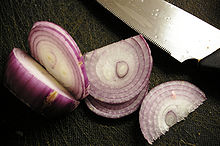User:Samharad/sandbox
 | This is a user sandbox of Samharad. You can use it for testing or practicing edits. This is not the sandbox where you should draft your assigned article for a dashboard.wikiedu.org course. To find the right sandbox for your assignment, visit your Dashboard course page and follow the Sandbox Draft link for your assigned article in the My Articles section. |
Eye irritation[edit]

Freshly cut onions often cause a stinging sensation in the eyes of people nearby, and often uncontrollable tears. This is caused by the release of a volatile gas, syn-propanethial-S-oxide, which stimulates nerves in the eye creating a stinging sensation.[1] This gas is produced by a chain of reactions which serve as a defence mechanism: chopping an onion causes damage to cells which releases enzymes called alliinases. These break down amino acid sulfoxides and generate sulfenic acids. A specific sulfenic acid, 1-propenesulfenic acid, is rapidly acted on by a second enzyme, the lacrimatory factor synthase, producing the syn-propanethial-S-oxide.[1] This gas diffuses through the air and soon reaches the eyes, where it activates sensory neurons. Lacrimal glands produce tears to dilute and flush out the irritant.[2]
Eye irritation can be avoided by cutting onions under running water or submerged in a basin of water.[2] Leaving the root end intact also reduces irritation as the onion base has a higher concentration of sulphur compounds than the rest of the bulb.[3] Refrigerating the onions before use reduces the enzyme reaction rate and using a fan can blow the gas away from the eyes. The more often one chops onions, the less one experiences eye irritation.[4]
The amount of sulfenic acids and lacrimal factor released and the irritation effect differs among Allium species. In 2008, the New Zealand Institute for Crop and Food Research created "no tears" onions by using gene-silencing biotechnology to prevent the synthesis of lachrymatory factor synthase in onions.[5] These LFS-silenced (or LFS−) onions have since been investigated for promising additional health benefits, including platelet aggregation reduction and weight control[6]. One study suggests that consumers prefer the flavor of onions with lower LFS content.[7] However, since the LFS-silencing process involves reducing sulfur ingestion by the plant, it has also been suggested that LFS− onions are inferior in both flavor and health benefits.[8] A method for efficiently differentiating LFS− and LFS+ onions has been developed based on mass spectrometry, with potential application in high-volume production;[9] gas chromatography is also used to measure lachrymatory factor in onions.[10][11] In early 2018, Bayer released the first crop yield of commercially-available LFS-silenced onions under the name "Sunions."[12] They were the product of 30 years of cross-breeding; genetic modification was not employed.[12][13]
Guinea hen weed and honey garlic contain a similar lachrymatory factor.[14] Synthetic onion lachrymatory factor has been used in a study related to tear production,[15] and has been proposed as a nonlethal deterrent against thieves and intruders.[16][17]
- ^ a b Cite error: The named reference
Eric Block 2010was invoked but never defined (see the help page). - ^ a b Scott, Thomas. "What is the chemical process that causes my eyes to tear when I peel an onion?". Ask the Experts: Chemistry. Scientific American. Retrieved 2007-04-28.
- ^ "FAQ". National Onion Association. Retrieved 2013-03-28.
- ^ Hiskey, Daven (2010-11-05). "Why onions make your eyes water". Today I Found Out. Retrieved 2013-03-28.
- ^ "Tearless Onion Created In Lab Using Gene Silencing". ScienceDaily. 5 February 2008. Retrieved 23 November 2016.
- ^ Thomson, Susan J.; Rippon, Paula; Butts, Chrissie; Olsen, Sarah; Shaw, Martin; Joyce, Nigel I.; Eady, Colin C. (2013-11-06). "Inhibition of Platelet Activation by Lachrymatory Factor Synthase (LFS)-Silenced (Tearless) Onion Juice". Journal of Agricultural and Food Chemistry. 61 (44): 10574–10581. doi:10.1021/jf4030213. ISSN 0021-8561. PMID 24147811.
- ^ Kim, Ha-Yeon; Jackson, Daniel; Adhikari, Koushik; Riner, Cliff; Sanchez-Brambila, Gabriela (2017-10-01). "Relationship Between Consumer Acceptability and Pungency-Related Flavor Compounds of Vidalia Onions". Journal of Food Science. 82 (10): 2396–2402. doi:10.1111/1750-3841.13915. ISSN 1750-3841. PMID 28898424.
- ^ Eady, Colin C.; Kamoi, Takahiro; Kato, Masahiro; Porter, Noel G.; Davis, Sheree; Shaw, Martin; Kamoi, Akiko; Imai, Shinsuke (2008-08-01). "Silencing Onion Lachrymatory Factor Synthase Causes a Significant Change in the Sulfur Secondary Metabolite Profile". Plant Physiology. 147 (4): 2096–2106. doi:10.1104/pp.108.123273. ISSN 0032-0889. PMC 2492635. PMID 18583530.
- ^ Joyce, Nigel I.; Eady, Colin C.; Silcock, Patrick; Perry, Nigel B.; van Klink, John W. (January 2013). "Fast Phenotyping of LFS-Silenced (Tearless) Onions by Desorption Electrospray Ionization Mass Spectrometry (DESI-MS)". Journal of Agricultural and Food Chemistry. 61 (7): 1449–1456. doi:10.1021/jf304444s. PMID 23350988 – via ACS Publications.
- ^ Tewari, Gyanendra M.; Bandyopadhyay, Chiranjib. (1975-07-01). "Quantitative evaluation of lachrymatory factor in onion by thin-layer chromatography". Journal of Agricultural and Food Chemistry. 23 (4): 645–647. doi:10.1021/jf60200a044. ISSN 0021-8561.
- ^ Schmidt, Norman E.; Santiago, Leanne M.; Eason, H. Donald; Dafford, Kurtus A.; Grooms, Chris A.; Link, Tammy E.; Manning, Dana T.; Cooper, Sylina D.; Keith, R. Chad (1996-01-01). "Rapid Extraction Method of Quantitating the Lachrymatory Factor of Onion Using Gas Chromatography". Journal of Agricultural and Food Chemistry. 44 (9): 2690–2693. doi:10.1021/jf950686s. ISSN 0021-8561.
- ^ a b Danovich, Tove (February 8, 2018). "Stop Crying! Tear-Free Onions Are Here". National Public Radio. Retrieved April 13, 2018.
- ^ Van Hare, Holly (19 December 2017). "Onions that don't make you cry are finally here". LA Times. Retrieved 15 April 2018.
- ^ Klein, Joanna (5 September 2017). "Why Onions Make You Cry". The New York Times. Retrieved 16 April 2018.
- ^ Higashihara, H., Yokoi, N., Aoyagi, M. et al. Jpn J Ophthalmol (2010) 54: 215. https://doi-org.proxy.lib.umich.edu/10.1007/s10384-009-0786-0
- ^ US patent 9482496B1, James Anthony Rocchi, Thomas John Stewart & Thomas John Stewart, "Wall-mounted nonlethal device for defending against intruders", published 2015-06-01, issued 2016-11-01, assigned to Fighting Chance Systems Inc
- ^ US patent 9890561B2, Yves Perrenoud, Daniel Idzkowski & Daniel Idzkowski, "Pressurized chemical theft deterrent device", published 2017-03-03, issued 2018-02-13, assigned to Skunklock Inc
